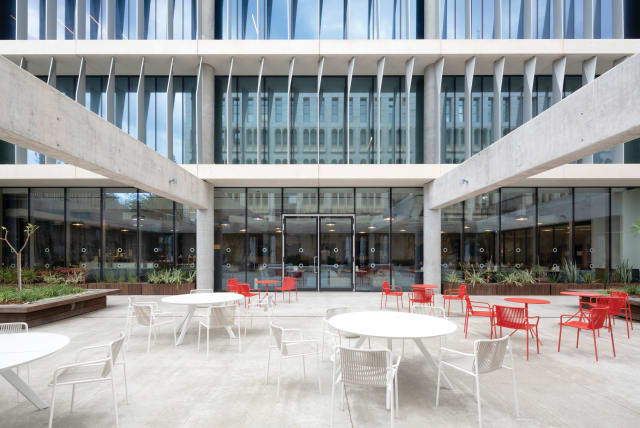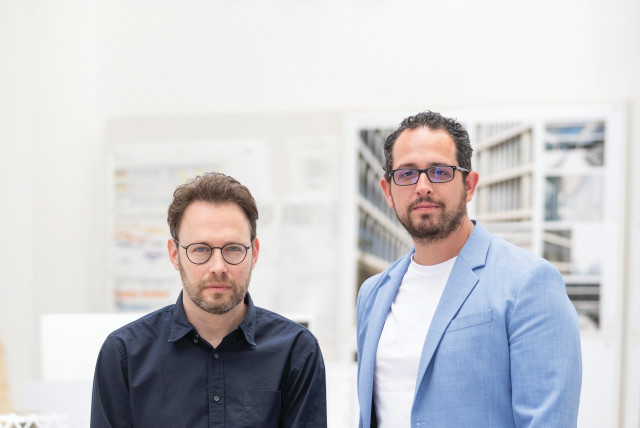TAU Faculty of Engineering Zarhy and Studio Pez win Rechter Prize for Young Architects

Zarhy won the prize for designing the Faculty of Engineering at the Tel Aviv University.
Winner of the prestigious Rechter Prize for Young Architects, Daniel Zarhy (43) hails from a prestigious lineage of architects.
“I am, in fact, the fourth generation in my family to pursue architecture,” he shared in an interview with The Jerusalem Post, shortly after clinching the esteemed Rechter Prize for young architects.
Zarhy won the prize for designing the Faculty of Engineering at the Tel Aviv University. The judges’ reasoning stated that “The project harnesses innovative engineering thinking, brilliantly intertwining technological and ecological perspectives, and fostering a genuinely distinctive architectural outcome. By creatively reinterpreting the modernist context of the campus structures in a contemporary light, Zarhy’s project reflects current global trends. The exceptional level of design and execution showcased by the project stands out prominently, deserving commendation within the Israeli context.”
Zarhy explained with pride, “My great-grandfather was Ze’ev Rechter. He met my grandfather, Moshe Zarhy, when they studied together at the Technion. Moshe married Rechter’s sister, and they established a firm that later split and was continued by my father.”
Zarhy graduated with honors from Tel Aviv University’s School of Architecture. In 2012, after working for renowned offices such as OMA – Rem Koolhaas in Rotterdam and Herzog & De Meuron in Basel, he founded Studio PEZ together with Pedro Peña.
The studio has won numerous international competitions, among them: The Jerusalem Courthouse, Ideas competition for a New Opera House in Busan, S. Korea, Broadcom’s R&D Center at Tel Aviv University, and most recently the campus for Bern’s University of Applied Science (in collaboration with Wulf Architetken).
Zarhy said that working abroad has influenced his work tremendously.
“I am influenced both by my family’s heritage – I practically had architecture streaming in my veins since childhood – and my work experiance, which gave me new and different perspectives. When you work in a big international firm with people who hail from around the globe, and everyone brings their point of view, it opens your mind, you get new ideas.”
Zarhy and Peña established STUDIOPEZ International Architecture Studio in 2012 – now based in Basel, Switzerland, and Tel-Aviv – as a continuation of their ongoing collaboration while working at Herzog & De Meuron.
“We started off working together in our spare time on two projects and won both. We thought this was it – we made it. But the reality was different, both projects never got completed but our partnership survived and flourished,” Zarhy said.
Duo begin journey
Observing the world’s rapid pace outstripping architecture’s ability to keep up, the duo began their venture by plunging into the depths. They successfully took on complex, large-scale projects and paved their way to solving major architectural challenges. Prioritizing simplicity over complexity, their goal in each project is to craft adaptable and people-centered spaces, fostering long-term benefits for communities and cities.
Since its establishment, PEZ has been able to showcase this philosophy in a significant number of successful projects and competition awards.
The building for which Zarhy received the prize houses both R&D Center for a worldwide leading semiconductor company and the Tel Aviv University Engineering Faculty.
“The building combines the engineering faculty with the semi-conductors’ research. Excluding the University Gallery, which was built 35 years ago, this is the first building on campus that was built with the idea of opening to the city.
“This is part of the changed attitude of the university. The campus perimeter, which for years was made up almost exclusively of car parking, will change to be made of buildings that will be open to the urban surroundings as well as the campus,” Zarhy explained.
Challenging the enclosed campus paradigm of the university, the building connects the city and the campus creating a meeting point for academia and industry.
“This is the first building in many years that rises from this level and connects the street outside the campus, to the university campus itself,” he said. “You can enter the building, and the University’s campus from the street that encircles the university, while on the other side of the ground floor - the street floor visually continues, forming a patio, or an enclosed four-meter deep shaded courtyard which is open to the cafeteria.“It is a new model of a research building – simple and efficient on one hand, and iconic on the other,” Zarhy said.
This building is, at the same time, both iconic by its merit, and simple by design. When looking for simplicity you sometimes come across the best ideas, new ideas,” said Zarhy proudly, stressing that his architectural vision is “to make a statement but to keep it simple”.
“Winning this prize was extremely important for us,” Zarhy concluded.
Jerusalem Post Store
`; document.getElementById("linkPremium").innerHTML = cont; var divWithLink = document.getElementById("premium-link"); if (divWithLink !== null && divWithLink !== 'undefined') { divWithLink.style.border = "solid 1px #cb0f3e"; divWithLink.style.textAlign = "center"; divWithLink.style.marginBottom = "15px"; divWithLink.style.marginTop = "15px"; divWithLink.style.width = "100%"; divWithLink.style.backgroundColor = "#122952"; divWithLink.style.color = "#ffffff"; divWithLink.style.lineHeight = "1.5"; } } (function (v, i) { });

